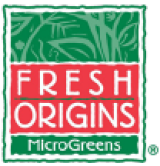


Micro Mustard Dijon™
Estimated Inventory, 4 oz : 1.00
This item was last sold on : 07/06/25
| Fresh Origins | Homepage |
Description/Taste
Micro Mustard Dijon™ are very small, flat leaves, averaging two centimeters in length and one centimeter in diameter, and have a broad, heart-like shape. The bright green leaves are smooth and uniform with defined, curved edges, connecting to a central, slender, and sturdy green stem. Micro Mustard Dijon™ has a crisp, succulent, and tender consistency. When consumed, the microgreens evoke an initially savory, subtly tangy taste that intensifies into a pleasantly sharp, pungent, and spicy, authentic Dijon mustard flavor with fresh, vegetal undertones.
Seasons/Availability
Micro Mustard Dijon™ is available year-round.
Current Facts
Micro Mustard Dijon™ consists of young, edible seedlings that are a part of a trademarked line of specialty microgreens grown by Fresh Origins Farm in San Diego, California. The small but potent leaves are a modern twist on the classic French condiment and are highly favored for their visual appeal and intense flavor. Micro Mustard Dijon™ is generally harvested 1 to 2 weeks after sowing, and chefs use the greens as an accent in savory dishes. The tender, crisp microgreens add layers of unexpected sharp flavors, elevating the dining experience, and can be individually placed on small plates or sprinkled across larger preparations for a lasting impression. In addition to being featured as an individual variety, Micro Mustard Dijon™ is included in the Fresh Origins Micro Spicy Mix™, a blend of multiple, snappy microgreens that create a zesty flavor combination.
Nutritional Value
Micro Mustard Dijon™ is a source of vitamin K to assist in wound healing and bone health and contains vitamin C to strengthen the immune system and reduce inflammation. The greens also provide small amounts of minerals, including copper, potassium, calcium, and iron. It is important to note that the vitamins and minerals are found primarily within the leaves and not in the stems of the microgreens. Growing conditions also significantly impact the nutritional content, and Fresh Origins cultivates their microgreens in a natural setting, an ideal climate for healthy, optimal greens.
Applications
Micro Mustard Dijon™ is best used fresh as an edible garnish. The bold, potent greens complement savory dishes and can be sprinkled onto salads with vinaigrette, topped over coleslaw, placed on omelets, or layered into sandwiches, including ham, pastrami, or corn beef. Micro Mustard Dijon™ can also be used as a bed of greens underneath seafood, floated on top of soups, curries, and stews, sprinkled over casseroles, macaroni and cheese, and pasta, or strategically placed on roasted meats to add color, flavor, and texture. The sharp microgreens adapt well in many different cuisines, including Indian, Italian, French, and Asian, and can be used in place of other pungent micros as a unique twist in sushi, bibimbap, stir-fries, and noodle dishes. In addition to savory applications, Micro Mustard Dijon™ can be muddled into cocktails for added flavor. Micro Mustard Dijon™ pairs well with root vegetables including, carrots, sweet potatoes, red potatoes, radish, beets, and parsnips, mushrooms, corn, peas, asparagus, cheeses such as gorgonzola, brie, and burrata, seafood including abalone, fish, mussels, and octopus, and meats such as ham, poultry, sausage, and lamb. Micro Mustard Dijon™ will generally keep 5 to 7 days stored in the refrigerator in a sealed container.
Ethnic/Cultural Info
Dijon mustard was developed in the 19th century in Dijon, the capital city in Burgundy, France. Legend has it that the Romans frequently ground mustard seeds as a flavoring for culinary dishes and began planting mustard throughout the Burgundy region in the 5th century. In the 14th century, mustard plants were widely naturalized throughout Dijon's hills and were even grown in vineyards below the grapevines. The plants acted as a cover crop for the grapevines, and when tilled into the soil, they contributed essential nutrients to nourish the vines. Mustard was documented as a favorite condiment of King Philip VI in the 14th century, but it wasn’t until the 19th century that Dijon resident Jean Naigeon adapted the original mustard recipe to be made with verjuice instead of vinegar. Verjuice is the sour juice of unripe grapes and was created to reduce waste in grape cultivation. The new mustard recipe was named Dijon, and the mustard quickly became a favored condiment for its smoother, potent flavor. In the modern-day, Fresh Origins uses Micro Mustard Dijon™ to capture the history and flavor of Dijon mustard while incorporating an element of whimsy through the greens to elevate the dining experience. Micro Mustard Dijon™ is a Fresh Origins exclusive and is a modern twist on the classic condiment. Chefs use the tiny greens to present an authentic mustard flavor in an unconventional, unexpected way.
Geography/History
Micro Mustard Dijon™ was developed at Fresh Origins Farm in San Diego, California, the leading American producer of naturally grown microgreens since the mid-1990s. Fresh Origins has been using the mild, Southern California climate year-round to produce robust, healthy, and flavorful microgreens for over twenty years, and the farm closely partners with chefs to create innovative varieties with unique flavorings. Fresh Origins also has the highest level third-party-audited food safety program and is a certified member of the California Leafy Greens Marketing Agreement, which follows science-based food safety practices to promote transparency and honesty in production. Today Micro Mustard Dijon™ can be found through select distribution partners of Fresh Origins across the United States, including Specialty Produce, and are also found through partners in Canada.
Featured Restaurants
Restaurants currently purchasing this product as an ingredient for their menu.
| Barra Oliba | San Diego CA | 610-310-5110 |
| Tom Hams Light House | San Diego CA | 619-291-9110 |
| Alila Marea Beach Resort | Encinitas CA | 805-539-9719 |
| Zeca Trading Co. | San Diego CA | 619-410-1576 |
| C 2 C | San Diego CA | 619-972-9345 |
Recipe Ideas
Recipes that include Micro Mustard Dijon™. One




 Learn More...
Learn More...
